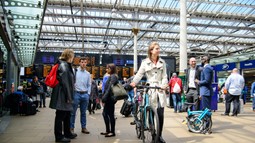Sustrans Scotland are broadly supportive of the Scottish Government’s Strategic Transport Projects Review 2 (STPR2). This review of the strategic transport network’s performance will inform transport investment in Scotland for the next 20 years (2022-2042) by providing evidence-based recommendations on which Scottish Ministers can base future transport investment decisions.

This review will contribute to improving active travel infrastructure in Scotland by promoting the development of infrastructure such as:
- Active freeways
- Village-town active travel connections
- Connecting towns by active travel
- Long distance active travel network
Sustrans Scotland’s key recommendations for improvements to the Strategic Transport Projects Review 2 are:
- 20-minute neighbourhoods
The focus of 'Connected neighbourhoods' on streets within 800m of a town centre is too limited to live up to the title of this option.
It would better support 20-minute neighbourhoods (1600m walking distance) if the scope of this option was expanded to include low-cost traffic reduction measures across all residential areas.
This would create the opportunity to achieve a strategic-level impact on modal shift away from private car use by targeting the environment where most people start their journeys.
- Public transport and active travel “competing”
We are concerned that some city-based mass-transit schemes may squeeze out space for active travel modes unless accompanied by motor vehicle demand management measures that prioritise space for people.
It also needs to be properly assessed whether mega-budget projects focussed on particular corridors create as much benefit as large programmes of smaller interventions spread over a wider area.
To date, rail improvements have not included sustainable access to stations - only addressing issues within the station itself.
Providing car parking at stations is an inefficient use of space and encourages local traffic into town centres to the detriment of business and walking, wheeling and cycling.
Our full response to the Scottish Government's STPR2 consultation
1 Were you aware of STPR2 prior to this consultation?
Yes
2 To what extent do you agree or disagree that the STPR2 process reflects the NTS2 Priorities and Outcomes?
Strongly agree
3 Please provide any further comments you have in relation to the STPR2 process.
-
4 To what extent do you agree or disagree that it was correct to take both a Regional and National approach to STPR2?
Strongly agree
5 Please provide any further comments:
Tay City regional workshops were an effective, collaborative way to produce an exhaustive list of regional project options.
Grouping projects into categories at a national level makes sense, though we have some disappointment that more region-specific projects weren't identified in the national report, particularly for active travel.
The plan has no local approach, but traffic regulations and their applications depend on local government budget.
6 To what extent do you agree or disagree that the engagement process has allowed you to provide a contribution to STPR2?
Neither agree nor disagree
7 Please provide any further comments you have on the engagement carried out throughout STPR2.
As a key stakeholder representing all of the Active Travel Delivery Partners, we are disappointed that we have not been involved in the discussions between the STPR2 consultants and Transport Scotland to refine the active travel options (the last Active Travel Stakeholder meeting was held in December 2019).
We therefore consider that our expertise and knowledge in strategic active travel delivery has not been adequately incorporated in to the STPR2 process.
Key Themes
8 Which of the overall key themes is your / your organisation’s top priority?
Improving active travel infrastructure
9 Which of the overall key themes is your / your organisation’s lowest priority?
Strengthening strategic connections
1. STPR2 Key Themes and Recommendations
10 To what extent do you agree or disagree that the recommendations under this theme will contribute to Improving Active Travel Infrastructure?
Connected neighbourhoods: Agree
Active freeways: Strongly agree
Village-town active travel connections: Strongly agree
Connecting towns by active travel: Strongly agree
Long distance active travel network: Strongly agree
11 Which of these recommendations would you prioritise to contribute to Improving Active Travel Infrastructure?
Connected neighbourhoods: Medium Priority
Active freeways: High Priority
Village-town active travel connections: Medium Priority
Connecting towns by active travel: Medium Priority
Long distance active travel network: Medium Priority
12 Do the recommendations under this theme address the transport needs of your local or regional area or the people your organisation represents?
Yes
13 Please provide any additional comments you have on the theme Improving Active Travel Infrastructure and the recommendations within it.
The focus of 'Connected neighbourhoods' on streets within 800m of a town centre is too limited to live up to the title of this option.
It would better support 20-minute neighbourhoods (1600m walking distance) if the scope of this option was expanded to include low-cost traffic reduction measures across all residential areas.
This would create the opportunity to achieve a strategic-level impact on modal shift away from private car use by targeting the environment where most people start their journeys.
We note and welcome that all of the inter-urban active travel options align with the development of the National Cycle Network.
However, it is important to note that the effectiveness of the existing network is constrained by varying quality of infrastructure.
Therefore, improving the existing network and plugging its gaps is as important, if not more so, than creating new routes.
2. Influencing Travel Choices and Behaviours
14 To what extent do you agree or disagree that the recommendations under this theme contribute to Influencing Travel Choices and Behaviours?
Behaviour change initiatives: Strongly agree
Changing road user behaviour: Agree
Increasing active travel to school: Strongly agree
Improving access to bikes: Strongly agree
Expansion of 20mph limits and zones: Agree
15 Which of these recommendations would you prioritise to contribute to Influencing Travel Choices and Behaviours?
Behaviour change initiatives: High Priority
Changing road user behaviour: High Priority
Increasing active travel to school: High Priority
Improving access to bikes: High Priority
Expansion of 20mph limits and zones: Medium Priority
16 Do the recommendations under this theme address the transport needs of your local or regional area or the people your organisation represents?
Yes
17 Please provide any additional comments you have on the theme Influencing Travel Choices and Behaviours and the recommendations within it.
A diverse and widely available range of behaviour change initiatives have the potential to achieve significant changes in personal travel behaviour and to capitalise on the infrastructure investment.
However, the behaviour change recommendation seems to imply blanket information/awareness raising of measures.
This measure should be refocused to use population segmentation at a local level to target population sub-groups, for example using social marketing.
3. Enhancing Access to Affordable Public Transport
18 To what extent do you agree or disagree that the recommendations under this theme contribute to Enhancing Access to Affordable Public?
Clyde Metro: Agree
Edinburgh & South East Scotland Mass Transit: Agree
Aberdeen Rapid Transit: Agree
Provision of strategic bus priority measures: Agree
Highland Mainline rail corridor enhancements: Agree
Perth- Dundee- Aberdeen rail corridor enhancements: Agree
Edinburgh/Glasgow – Perth/Dundee rail corridor enhancements: Agree
Supporting integrated journeys at ferry terminals: Agree
Infrastructure to provide access for all at railway stations: Strongly agree
Investment in DRT and MaaS: Agree
Improved public transport passenger interchange facilities: Agree
Framework for delivery of mobility hubs: Agree
Smart, integrated public transport ticketing: Agree
19 Which of these recommendations would you prioritise to contribute to Enhancing Access to Affordable Public Transport?
Clyde Metro: Medium Priority
Edinburgh & South East Scotland Mass Transit: Medium Priority
Aberdeen Rapid Transit: Medium Priority
Provision of strategic bus priority measures: Medium Priority
Highland Mainline rail corridor enhancements: Medium Priority
Perth- Dundee- Aberdeen rail corridor enhancements: Medium Priority
Edinburgh/Glasgow – Perth/Dundee rail corridor enhancements: Medium Priority
Supporting integrated journeys at ferry terminals: Medium Priority
Infrastructure to provide access for all at railway stations: High Priority
Investment in DRT and MaaS: Low Priority
Improved public transport passenger interchange facilities: Medium Priority
Framework for delivery of mobility hubs: Low Priority
Smart, integrated public transport ticketing: Medium Priority
20 Do the recommendations under this theme address the transport needs of your local or regional area or the people your organisation represents?
Yes
21 Please provide any additional comments you have on the theme Enhancing Access to Affordable Public Transport and the recommendations within it
We are concerned that some city-based mass-transit schemes may squeeze out space for active travel modes unless accompanied by motor vehicle demand management measures that prioritise space for people. It also needs to be properly assessed whether mega-budget projects focussed on particular corridors create as much benefit as large programmes of smaller interventions spread over a wider area.
To date, rail improvements have not included sustainable access to stations - only addressing issues within the station itself. Providing car parking at stations is space inefficient and encourages local traffic into town centres to the detriment of business and walking, cycling and wheeling.
Integrated ticketing should seek to include access to cycle hire schemes as well to provide seamless end to end journeys via integrated active travel and public transport.
Infrastructure to provide access for all at railway stations: this should be strengthened to ensure that it is possible for all users have equal value regardless of their travel mode.
4. Decarbonising Transport
22 To what extent do you agree or disagree that the recommendations under this theme contribute to Decarbonising Transport?
Ferry vessel renewal and replacement and progressive decarbonisation: Don’t Know / No Opinion
Rail decarbonisation: Don’t Know / No Opinion
Decarbonisation of bus network: Don’t Know / No Opinion
Behaviour change and modal shift for freight: Don’t Know / No Opinion
Zero emissions vehicles and infrastructure transition: Don’t Know / No Opinion
23 Which of these recommendations would you prioritise to contribute to Decarbonising Transport?
Ferry vessel renewal and replacement and progressive decarbonisation: Don’t Know / No Opinion
Rail decarbonisation: Don’t Know / No Opinion
Decarbonisation of bus network: Don’t Know / No Opinion
Behaviour change and modal shift for freight: Don’t Know / No Opinion
Zero emissions vehicles and infrastructure transition: Don’t Know / No Opinion
24 Do the recommendations under this theme address the transport needs of your local or regional area or the people your organisation represents?
Don’t Know / No Opinion
25 Please provide any additional comments you have on the theme Decarbonising Transport and the recommendations within it.
Transport emissions are the highest source of Scotland's carbon emissions, and the only sector (from heat, agriculture, industry) that has not decreased since 1990. Sustrans advocates strongest possible measures to decarbonise transport by reducing dependency on private vehicles and facilitating modal shift from cars to public transport and active travel.
5. Increasing Safety and Resilience on the Strategic Transport Network
26 To what extent do you agree or disagree that the recommendations under this theme contribute to Increasing Safety and Resilience on the Strategic Transport Network?
Access to Argyll A83: Don’t Know / No Opinion
Trunk road and motorway safety Improvements: Don’t Know / No Opinion
Trunk road and motorway network climate change adaption and resilience: Don’t Know / No Opinion
Trunk road and motorway network renewal for reliability, resilience and safety: Don’t Know / No Opinion
Enhancing Intelligent Transport Systems: Don’t Know / No Opinion
Strategy for improving rest and welfare facilities for hauliers: Don’t Know / No Opinion
Improving active travel on trunk roads through communities: Agree
Speed management plan: Strongly agree
27 Which of these recommendations would you prioritise to contribute to Increasing Safety and Resilience on the Strategic Transport Network?
Access to Argyll A83: Don’t Know / No Opinion
Trunk road and motorway safety Improvements: Don’t Know / No Opinion
Trunk road and motorway network climate change adaption and resilience: Don’t Know / No Opinion
Trunk road and motorway network renewal for reliability, resilience and safety: Don’t Know / No Opinion
Enhancing Intelligent Transport Systems: Don’t Know / No Opinion
Strategy for improving rest and welfare facilities for hauliers: Don’t Know / No Opinion
Improving active travel on trunk roads through communities: Medium Priority
Speed management plan: Medium Priority
28 Do the recommendations under this theme address the transport needs of your local or regional area or the people your organisation represents?
Don’t Know / No Opinion
29 Please provide any additional comments you have on the theme Increasing Safety and Resilience on the Strategic Transport Network and the recommendations within it.
Where road bypasses are proposed these should only be implemented where:
- Other options to encourage modal shift to other modes has been fully considered
- The full cost of demand management/placemaking measures in the town being bypassed have been included within the project scope/budget.
Otherwise, many of the supposed benefits to the town will be lost when the less congested roads encourage more people to drive.
6. Strengthening Strategic Connections
30 To what extent do you agree or disagree that the recommendations under this theme contribute to Strengthening Strategic Connections?
Sustainable access to Grangemouth Investment Zone: Don’t Know / No Opinion
Access to Stranraer and ports at Cairnryan: Don’t Know / No Opinion
Potential fixed links in Outer Hebrides and Mull: Don’t Know / No Opinion
Investment in ports infrastructure: Don’t Know / No Opinion
Major station masterplans: Agree
Rail freight terminals: Don’t Know / No Opinion
High speed and cross border rail enhancements: Don’t Know / No Opinion
31 Which of these recommendations would you prioritise to contribute to Strengthening Strategic Connections?
Sustainable access to Grangemouth Investment Zone: Do not support this recommendation
Access to Stranraer and ports at Cairnryan: Do not support this recommendation
Potential fixed links in Outer Hebrides and Mull: Don’t Know / No Opinion
Investment in ports and infrastructure: Don’t Know / No Opinion
Major station masterplans: Medium Priority
Rail freight terminals: Don’t Know / No Opinion
High speed and cross border rail enhancements: Don’t Know / No Opinion
32 Do the recommendations under this theme address the transport needs of your local or regional area or the people your organisation represents?
Don’t Know / No Opinion
33 Please provide any additional comments you have on the theme Strengthening Strategic Connections and the recommendations within it.
Major station masterplans should seek to improve both increased active travel access and storage. Any fixed links to islands should include high quality active travel provision
Access to Stranraer and the Ports at Cairnryan: While Sustrans does not have details on the proposed plans, we anticipate that this will involve a large number of road upgrades to facilitate more traffic. This goes against National Transport Strategy (NTS2) outcomes. We are not seeing a corresponding set of proposals to facilitate travel to Stranraer / Cairnryan either by public transport or using active travel options.
STPR2 Recommendations and other Scottish Government Policy
34 Prior to this consultation were you aware of the list of Scottish Government policies below, which STPR2 aligns with and supports?
Take action against climate change: Yes
Decarbonising transport: Yes
Reducing car use: Yes
Encouraging greater walking, wheeling and cycling: Yes
Addressing inequalities, such as: Child poverty: Yes
Addressing inequalities, such as: Affordability of transport: Yes
Addressing inequalities, such as: Access to transport: Yes
Transport as an enabler of inclusive economic growth: Yes
Providing a safe transport system: Yes
Providing a reliable and resilient transport system: Yes
35 Prior to this consultation were you aware of the Scottish Government policy documents to which STPR2 aligns with and supports?
National Transport Strategy 2 (NTS2): Yes
National Planning Framework (NPF4): Yes
Climate Change Plan Update & Route Map: Yes
Infrastructure Investment Plan: Yes
Cleaner Air for Scotland 2 & Delivery Plan: Yes
National Performance Framework: Yes
36 To what extent do you agree or disagree that the STPR2 recommendations reflect and will contribute to the aims of government policy?
Agree
37 Please provide any additional comments you have on the STPR2 recommendations’ contribution to Government policy.
-
Strategic Environmental Assessment (SEA) & Other Impact Assessments
38 To what extent do you agree or disagree with the overall findings of the SEA?
Don’t Know / No Opinion
39 The SEA has reviewed plans, policies and programmes relevant to STPR2. Are there any other plans, policies and programmes that should be considered?
Don't Know
40 The SEA sets out the current national and regional baseline environment conditions and future trends. Do you have any comments on this baseline data?
Don't Know
41 Are there any particular issues, problems or opportunities you would like to mention that have not been captured within the SEA?
Yes
If yes, please provide further comments:
Looking at the wider economic context, oil price hikes due to Russian sanctions will lead to transport poverty increasing. Wider global trade impacts could lead to logistics issues that could affect active travel infrastructure delivery timelines and costs.





